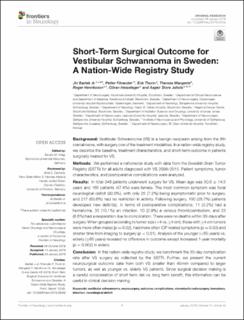| dc.description.abstract | Background: Vestibular Schwannoma (VS) is a benign neoplasm arising from the 8th cranial nerve, with surgery one of the treatment modalities. In a nation-wide registry study, we describe the baseline, treatment characteristics, and short-term outcome in patients surgically treated for VS.
Methods: We performed a nationwide study with data from the Swedish Brain Tumor Registry (SBTR) for all adults diagnosed with VS 2009–2015. Patient symptoms, tumor characteristics, and postoperative complications were analyzed.
Results: In total 348 patients underwent surgery for VS. Mean age was 50.6 ± 14.5 years and 165 patients (47.4%) were female. The most common symptom was focal neurological deficit (92.0%), with only 25 (7.2%) being asymptomatic prior to surgery, and 217 (63.6%) had no restriction in activity. Following surgery, 100 (28.7%) patients developed new deficit(s). In terms of postoperative complications; 11 (3.2%) had a hematoma, 35 (10.1%) an infection, 10 (2.9%) a venous thromboembolism, and 23 (6.6%) had a reoperation due to complication. There were no deaths within 30-days after surgery. When grouped according to tumor size (< 4 vs. ≥4 cm), those with ≥4 cm tumors were more often males (p = 0.02), had more often ICP related symptoms (p = 0.03) and shorter time from imaging to surgery (p < 0.01). Analysis of the younger (< 65 years) vs. elderly (≥65 years) revealed no difference in outcome except increased 1-year mortality (p = 0.002) in elderly.
Conclusion: In this nation-wide registry-study, we benchmark the 30-day complication rate after VS surgery as collected by the SBTR. Further, we present the current neurosurgical outcome data from both VS smaller than 40 mm compared to larger tumors, as well as younger vs. elderly VS patients. Since surgical decision making is a careful consideration of short term risk vs. long term benefit, this information can be useful in clinical decision making. | en_US |

